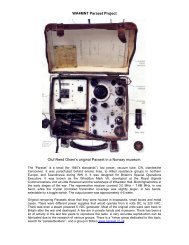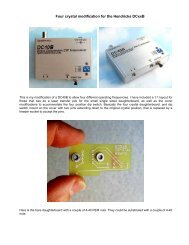Small Magnetic Loop Antenna Project - QRPBuilder.com
Small Magnetic Loop Antenna Project - QRPBuilder.com
Small Magnetic Loop Antenna Project - QRPBuilder.com
Create successful ePaper yourself
Turn your PDF publications into a flip-book with our unique Google optimized e-Paper software.
A balanced loop antenna, however, is inherently immune to such problems because the<br />
ground below the antennas does not form the missing half of the antenna circuit in respect<br />
of supporting ground-return currents as it does with a vertical whip / monopole antenna.<br />
Therefore the multiple current paths to ground (earth) are eliminated with the loop. Of<br />
course both the loop and the whip are subject to the well-known wave interference effects<br />
in elevation due to height above the ground (or water).<br />
Reflective metal objects having a size greater than about 1/3 of a wavelength and at a<br />
distance of less than about 2 wavelengths from the loop antenna can produce standing<br />
wave “nulls” in a given direction at various frequencies. If the antenna is to be mounted<br />
atop a metal roof, diffraction interference from the edge of the building roof should be<br />
considered if undesirable nulls in certain directions at some frequencies are to be avoided.<br />
Usually the best location is near the edge of such a conductive roof, in the direction of the<br />
desired signal or signals.<br />
<strong>Loop</strong> Directivity:<br />
It is <strong>com</strong>monly believed that a vertically oriented loop antenna exhibits a bi-directional<br />
pattern with maximum reception occurring in the plane of the loop. Although this is true<br />
for vertically polarised sky-wave signals arriving at very low elevation angles (less than<br />
about 10 degrees) and for ground-wave signals, it is certainly not true for reception of high<br />
angle sky-waves (greater than about 30 degrees) whose polarisation usually rotates from<br />
vertical to horizontal at a fairly random rate due to “Faraday Rotation” of free-electrons<br />
within the ionosphere. At angles exceeding 45 degrees, the loop response shifts to a<br />
preference for horizontal polarisation arriving at an azimuth angle of 90 degrees with<br />
respect to the plane of the loop. Thus, for short-range <strong>com</strong>munication links, i.e. less than<br />
about 500 km, best reception will usually occur with the loop rotated 90 degrees, that is,<br />
the plane of the loop perpendicular to the azimuthal arrival angle.<br />
It is not easy to predict which azimuthal bearing will provide the best night-time reception<br />
with a loop over paths of less than about 500 km at frequencies of less than about 7 MHz.<br />
This is due to the prevalence of both sky-wave and ground-wave signals which randomly<br />
<strong>com</strong>bine to produce rather serious fading. Usually, trial and error is the best solution for<br />
determining which antenna orientation will produce the most favourable <strong>com</strong>promise<br />
between the highest average signal-strength and the least troublesome fading. Generally for<br />
distances exceeding 500 to 1000 km, the best orientation is with the plane of the loop in the<br />
direction of the arriving signal. Further, the side nulls exhibited by the loop at low<br />
elevation angles may be used to “null-out” the ground-wave signal to reduce fading when<br />
sky-wave propagation exists simultaneously. In <strong>com</strong>parison a vertical whip has a null<br />
overhead and thus is ineffective for short and medium distances. A vertical loop antenna<br />
located less than about 0.15 λ above ground exhibits excellent coverage from the zenith<br />
down to almost zero degrees in the elevation plane making the loop useful over almost any<br />
distance range. At elevation angles higher than about 20 degrees, a loop is almost<br />
omnidirectional in azimuth when receiving sky-wave signals.<br />
For a loop above average ground, as opposed to ground having perfect conductivity, the<br />
response at very low vertical angles e.g. less than about 5 degrees, is typically 10 dB or<br />
more below the achievable response above perfect ground. It is perhaps worthy to note that<br />
the ground immediately below the loop principally affects the response at high vertical<br />
angles while the properties of the ground at a large radius distance from the antenna tends<br />
to characterise the performance of the loop at low vertical angles in the plane of the loop.<br />
7





